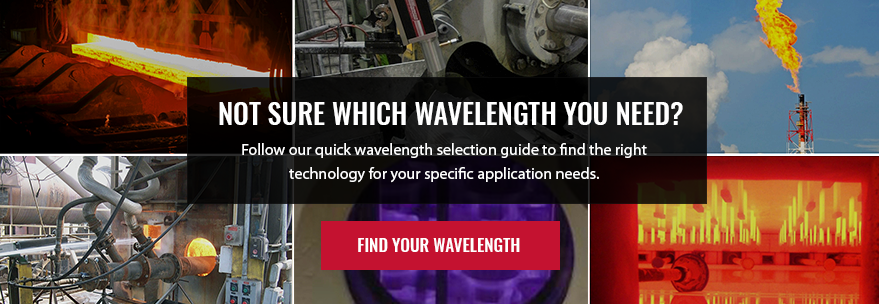Pyrometers, or infrared temperature sensors, have been around for quite some time now and as you can imagine come in all different types and varieties. Many of them have different temperature spans, different optics, different designs, features, etc. There are thousands of different pyrometers available on the market today, so how do you tell the difference between them all.
 Taking a step back and looking at the pyrometer market from a broader perspective, there really are only 6 different pyrometer technologies – each with their own unique characteristics and capabilities. 6 technologies are a lot easier to manage than making sense of the thousands of options available.
Taking a step back and looking at the pyrometer market from a broader perspective, there really are only 6 different pyrometer technologies – each with their own unique characteristics and capabilities. 6 technologies are a lot easier to manage than making sense of the thousands of options available.
- Short-Wavelength Pyrometers
- Long-Wavelength Pyrometers
- Specialty-Wavelength Pyrometers
- Two-Color Pyrometers
- Dual-Wavelength Pyrometers
- Multi-Wavelength Pyrometers
Below is a short description of each technology
1. Short-Wavelength Pyrometers
Short-Wavelength pyrometers can be defined as those that are short than 3um. Compared with Long-Wavelength pyrometers, errors are relatively small for moderate emissivity variation, optical obstruction and misalignment.
Additionally, with careful wavelength selection, certain short-wavelength pyrometers can view through common interferences like steam, flames, combustion gasses, water, and plasma.
2. Long-Wavelength Pyrometers
Long-Wavelength pyrometers are typically 8-14um. These are general purpose pyrometers that are ideal for measuring low-temperatures (below 100°C / 212°F) and high-emissivity materials. A change in emissivity will result in a large temperature for long-wavelength pyrometers. Handheld IR sensors are a good example of a long-wavelength pyrometer
3. Specialty-Wavelength Pyrometers
Specialty-Wavelength pyrometers are exactly like they sound. They are filtered at very particular and special wavelengths where a particular material is either transparent or opaque at that particular wavelength. Some examples include Glass, Carbon-based flames, thin-film plastics, and others. These pyrometers are used for specific applications.
4. Two-Color Pyrometers
Two-Color pyrometers are a type of ratio pyrometer. Ratio pyrometers measure infrared energy at two wavelengths and convert the ratio of measured energy at both wavelengths to a temperature reading. This technology allows ratio pyrometers to compensate for emissivity variation for most materials. Two-color pyrometers can also tolerate partial misalignment and dirty windows. With a fixed wavelength set, two-color pyrometers are limited in the fact that they cannot view through common interferences like steam, flames, combustion gasses, plasmas, and water.
5. Dual-Wavelength Pyrometers
Dual-Wavelength pyrometers have the same features as two-color pyrometers but with some significant added capabilities. Dual-Wavelength technology differs from two-color technology in that dual-wavelength pyrometers use separate, distinct, and selectable wavelength sets. With the ability to carefully select wavelength sets, certain dual-wavelength pyrometers can view through steam, flames, water, combustion gasses, and plasmas. The separate and distinct wavelength sets also allow dual-wavelength pyrometers to tolerate scale 20x better than two-color pyrometers. Additionally, because the dual-wavelength pyrometer is weighted to the hottest spot in its field of view, it can much better tolerate severe misalignment and dirty windows compared with the two-color pyrometer.
6. Multi-Wavelength Pyrometers
Multi-Wavelength pyrometers are used for specific non-greybody materials with unique emissivity characteristics. These materials include aluminum, copper, specialty steels, zinc. Application-specific algorithms correct for complex emissivity characteristics.

